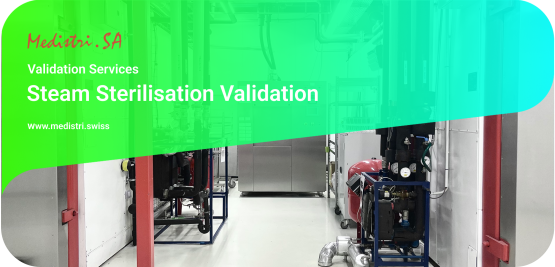(Download: Steam Sterilisation Validation in PDF by Medistri)
Sterilization refers to the process of removing, kill, or deactivate all forms of life (microorganisms such as fungi, bacteria, spores, and unicellular eukaryotic organisms) and other biological agents.
Steam sterilization is a common method used for sterilising items or goods that can withstand the moisture and the relatively high temperature and pressure. The main purpose of steam sterilization is to deactivate microorganisms through total elimination of germs providing a sterile product for later use.
Steam sterilization validation is important because it ensures that a product with a sterile claim meets the Sterility Assurance Level (SAL) claimed. The purpose of sterilization is to inactivate microbiological contaminants, thereby rendering products sterile. Validated and controlled manufacturing processes are necessary to ensure that sterility requirements are reached for all products and containers during steam sterilisation.
👉 To ensure that the process continues to provide safe and sterile results, manufacturers must comply with established standards and norms such as ISO 17665.
This standard specifies the requirements for the development, validation, and routine control of a moist heat sterilization process for medical devices. .
The validation of steam sterilization on products includes both physical and microbiological qualification processes. These processes are performed to ensure that the sterilization process is effective in deactivating microorganisms and providing a sterile product for later use.
Physical qualification processes are performed to ensure that the sterilizer is functioning properly and effectively sterilizing the items placed inside. Some of the tests and procedures involved in the physical qualification process include:
Bowie-Dick Test: This test is performed to check for steam penetration and air removal. It is typically performed using a test pack that contains a chemical indicator.
Empty Chamber Heat Distribution Studies: This test is performed to establish the uniformity of temperature distribution in the sterilizer chamber and to identify the location of the “coolest point”. It is typically performed using a calibrated temperature data logger with multiple probes placed at different locations within the chamber.
Loaded Chamber Heat Distribution & Penetration Studies: This test is performed to check for heat distribution and penetration in a loaded chamber. It is typically performed using a fixed loading pattern and a calibrated temperature data logger with multiple probes placed at different locations within the chamber.
Microbiological qualification processes involve testing with biological indicators to ensure that the sterilization process is achieving the desired sterility assurance level. Biological indicators are used to monitor the effectiveness of the sterilization process by providing a direct measure of the lethality of the process.
At Medistri, there are also regular qualification and validation procedures that are performed, such as daily routine control of sterilizers, as well as periodic re-qualification to ensure that the sterilizer continues to function properly and effectively.
Our experts will work closely with your team through the multiple phases of the process to create a sterilisation validation report. The validation report details the process analysis and test results for your validation process. This ensures transparency and traceability at every stage of the project. Our experts gather all the data, present the results and make recommendations in a transparent, detailed and accurate manner.
Medistri offers complete validation of products for steam sterilisation according to ISO 17665. ISO 17665 specifies requirements for the development, validation and routine control of a moist heat sterilisation process for medical devices. The validation of products for steam sterilisation according to ISO 17665 involves several steps. These include:
- Equipment calibration
- Component mapping
- Load mapping
- Biological indicator selection
- Established Steam Sterilisation Infrastructure
- Heat penetration with microbiological challenge
- Routine process control maintenance
Steam sterilisation processes use saturated steam, under pressure, for a specified exposure time and at a specified temperature, as the sterilising agent. FDA states that for reusable devices intended to be sterilized, at least one validated microbicidal method for sterilization must be specified.
Medistri's in-house laboratory is a full-service contract laboratory, specialised in microbiology, analytical, bioanalytical chemistry & cell biology services, custom synthesis, and R&D. Our in-house laboratory will confirm that the sterilisation process was effective through the following tests:
- Endotoxin/LAL
- Sterility Testing
👉 Our experts aggregate all data, present the results and recommend risk management proposals in a transparent, detailed and accurate manner.
Steam sterilisation validation integrates physical and microbiological qualification processes and involves several steps that, when followed and monitored, it is possible to ensure that products are properly sterilized and safe for use.
Work with Medistri's team to identify the worst-case sterilisation location as well as all the sterilisation complexities of our final products. Using precise data-points, our team will identify the ideal placement for the biological indicators for complete monitoring of the validation.
🎯 To learn more about Medistri’s Steam Sterilisation Validation, visit on our website at www.medistri.swiss or directly contact our team at contact@medistri.swiss.
- The Medistri Team
#Medistri
